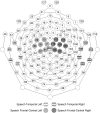Atypical speech versus non-speech detection and discrimination in 4- to 6- yr old children with autism spectrum disorder: An ERP study
- PMID: 28738063
- PMCID: PMC5524336
- DOI: 10.1371/journal.pone.0181354
Atypical speech versus non-speech detection and discrimination in 4- to 6- yr old children with autism spectrum disorder: An ERP study
Abstract
Previous event-related potential (ERP) research utilizing oddball stimulus paradigms suggests diminished processing of speech versus non-speech sounds in children with an Autism Spectrum Disorder (ASD). However, brain mechanisms underlying these speech processing abnormalities, and to what extent they are related to poor language abilities in this population remain unknown. In the current study, we utilized a novel paired repetition paradigm in order to investigate ERP responses associated with the detection and discrimination of speech and non-speech sounds in 4- to 6-year old children with ASD, compared with gender and verbal age matched controls. ERPs were recorded while children passively listened to pairs of stimuli that were either both speech sounds, both non-speech sounds, speech followed by non-speech, or non-speech followed by speech. Control participants exhibited N330 match/mismatch responses measured from temporal electrodes, reflecting speech versus non-speech detection, bilaterally, whereas children with ASD exhibited this effect only over temporal electrodes in the left hemisphere. Furthermore, while the control groups exhibited match/mismatch effects at approximately 600 ms (central N600, temporal P600) when a non-speech sound was followed by a speech sound, these effects were absent in the ASD group. These findings suggest that children with ASD fail to activate right hemisphere mechanisms, likely associated with social or emotional aspects of speech detection, when distinguishing non-speech from speech stimuli. Together, these results demonstrate the presence of atypical speech versus non-speech processing in children with ASD when compared with typically developing children matched on verbal age.
Conflict of interest statement
Figures







References
-
- American Psychiatric Association. Diagnostic and Statistical Manual of Mental Disorders, fifth Edition. Diagnostic and Statistical Manual of Mental Disorders 4th edition TR. 2013. 280 p.
-
- Constantino JN, Charman T. Diagnosis of autism spectrum disorder: reconciling the syndrome, its diverse origins, and variation in expression. Lancet Neurol. 2016;15(3):279–91. doi: 10.1016/S1474-4422(15)00151-9 - DOI - PubMed
-
- Volkmar FR, McPartland JC. From Kanner to DSM-5: autism as an evolving diagnostic concept. [Internet]. Vol. 10, Annual review of clinical psychology. 2014. p. 193–212. Available from: http://www.ncbi.nlm.nih.gov/pubmed/24329180 doi: 10.1146/annurev-clinpsy-032813-153710 - DOI - PubMed
-
- Dawson G, Bernier R, Ring RH. Social attention: a possible early indicator of efficacy in autism clinical trials. J Neurodev Disord [Internet]. 2012;4(1):11 Available from: http://www.ncbi.nlm.nih.gov/pubmed/22958480 - PMC - PubMed
-
- Dawson G, Toth K, Abbott R, Osterling J, Munson J, Estes A, et al. Early social attention impairments in autism: social orienting, joint attention, and attention to distress. Dev Psychol. 2004;40(2):271–83. doi: 10.1037/0012-1649.40.2.271 - DOI - PubMed
MeSH terms
LinkOut - more resources
Full Text Sources
Other Literature Sources
Medical

